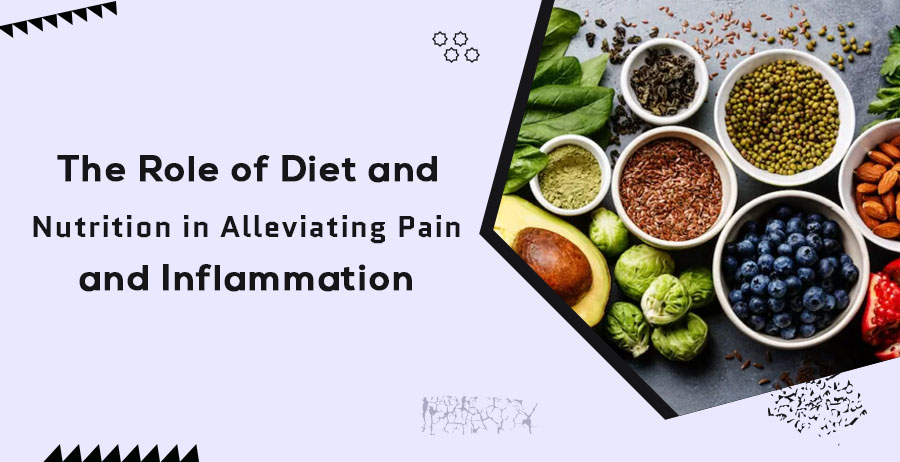Table of Contents
The Role of Diet and Nutrition in Alleviating Pain and Inflammation
Overview:
Millions of people around the world suffer from pain and inflammation. It doesn’t matter if the pain is acute from an injury or chronic from a medical condition.
Pain can be a big deal. Inflammation, including infection, injury, and chronic disease, can cause it.
Pain and inflammation can be managed in several ways. Diet and nutrition are the most effective.
In this article, we will learn about the role of diet and nutrition in alleviating pain and inflammation.
What is Inflammation?
An inflamed body protects itself from infection, illness, or injury. White blood cells, immune cells, and substances called cytokines are produced as part of the inflammatory response.
It’s natural for your immune system to respond to injury, illness, or other harm by inflaming. Your immune system responds to infections, wounds, tissue damage, and toxins in your body.
Normally, injuries can’t heal without inflammation, but chronic inflammation can develop if it goes on too long.
As a result, you could develop arthritis, diabetes, heart disease, or even cancer. And even some cancers if left untreated.
The body uses inflammation to heal and defend itself from harm. Chronic inflammation, on the other hand, can be harmful.
Various health problems can be caused by chronic inflammation. But, when it comes to reducing inflammation and improving your health, you can do many things.
Inflammation: Why does it occur?
There are a lot of times when inflammation is natural. Injury healing wouldn’t be possible without inflammation.
In response to physical injury or sickness, it promotes healing inflammation, and pain usually go hand-in-hand.
So, it’s probably also inflamed. You’re feeling injuries in a certain area. Inflammation occurs when wounds, infections, tissue damage, or toxins trigger your immune system.
Inflammation is generally good. But, chronic inflammation can signal something deeper. Consult a physical therapist as soon as possible.
Your inflammation has persisted for three months or longer. Nutritious foods can naturally, easily, and safely ease your pain and inflammation.
The Causes of Pain and Inflammation
Taking care of pain and inflammation starts with understanding what causes them. You should seek medical attention.
Neuro Seliron 300 mg and Pain O Soma 350 mg are used for pain relief. You are experiencing pain in your body.
It happens for many reasons. It includes injury, infection, inflammation, and chronic diseases.
However, the body’s immune system responds to injury, infection, or other stimuli with inflammation.
While inflammation is a necessary reaction to injury or infection. It can cause various health problems.
-
Pain and inflammation can be alleviated by diet and nutrition
Eating right and staying healthy are essential to beat inflammation and pain. Some foods can reduce inflammation in the body, and some foods can aggravate it.
You can manage pain and inflammation with a healthy diet and nutrition.
-
Inflammatory foods should be reduced
Some foods cause inflammation in the body. Foods like processed foods, refined carbohydrates, sugar, saturated and trans fats, and red meat are high in these things.
Inflammation and pain can be reduced by reducing your consumption of these foods. Instead, eating whole foods like whole grains, lean proteins vegetables, and fruits, reduces inflammation.
-
Consume more anti-inflammatory foods
The anti-inflammatory properties of certain foods have been well documented. Some of these include fatty fish (like salmon). Nuts, seeds, fruits (like berries).
Vegetables (like leafy greens), herbs, and spices (like turmeric). It will help reduce inflammation and relieve pain. If you eat these things more.
-
The Omega-3 fatty acids
Your body can’t make omega-3 fatty acids independently. Inflammation and pain can be relieved by their anti-inflammatory properties.
Chia seeds, flax seeds, walnuts, salmon, and mackerel are all good sources of omega-3 fatty acids. It is also possible to take a supplement containing omega-3 fatty acids.
-
Antioxidants
You get antioxidants from foods that protect your body against free radical damage. Anti-inflammatory properties are also known to be in them.
Berry, dark chocolate, green tea, and vegetables (like kale and spinach) are all antioxidants.
-
Make sure you avoid food triggers
Certain foods can trigger inflammation and pain. It can be histamine-rich foods (like fermented foods). Nightshade vegetables (like tomatoes and peppers), or gluten-containing foods.
The use of foods that you are intolerant to or sensitive to may help reduce pain and inflammation. If you have a food intolerance or sensitivity.
-
Hydration
It’s essential to stay hydrated to prevent pain and inflammation. Besides drinking lots of water, add foods with high water content to your diet, like cucumbers and watermelon.
Diet and the Role It Plays
Eat anti-inflammatory foods instead of inflammatory ones. Use Pain O Soma 500mg to reduce pain and inflammation.
Avoid highly processed foods with added sugar and oils, and eat whole, nutrient-dense foods that contain antioxidants.
By reducing free radicals, antioxidants work. When they’re not kept in check, these reactive molecules can cause inflammation.
A healthy anti-inflammatory diet should include protein, carbs, and fat at every meal. Keep your body hydrated, and ensure it gets the necessary vitamins, minerals, and fiber.
Diets like the Mediterranean diet have been shown to reduce inflammatory markers like CRP and IL-6.
Inflammation can also be reduced by a low-carb diet. Especially for people with obesity. Besides that, vegetarian diets are anti-inflammatory.
Foods to Eat
Many patients who follow an anti-inflammatory diet report that their symptoms go down. A diet supporting toxin removal can help speed up the healing process as the body purifies during inflammation.
The following foods should be included in your diet as anti-inflammatory foods.
- 🥦Vegetables: Cabbage, Cauliflower, Broccoli, Kale, Brussels Sprouts, etc.
- 🍍🍎🍓🍇Fruit: Blueberries, Pomegranates, Grapes, Cherries, and other fruits with deep colors.
- 🍐High-fat fruits: Olives and Avocados.
- 🥑Healthy fats: Avocado oil and Olive oil.
- 🐟Fatty fish: Anchovies, Mackerel, Herring, Salmon, and Sardines.
- 🥜Nuts: Nuts such as Almonds.
- 🌶️Peppers: Both Bell Peppers and Chili Peppers.
- 🍫Chocolate: Chocolate with a dark color.
- 🍛Spices: Fenugreek, Turmeric, Cinnamon, etc.
- 🍵Tea: Green Tea
- 🍷Red wine: Research suggests that resveratrol is an anti-inflammatory compound in wine that may benefit health.
✍Conclusion
Pain and inflammation can significantly affect an individual’s quality of life. You can ease these conditions, though, by changing your diet.
Reducing inflammation, increasing anti-inflammatory foods, and eating omega-3 fatty acids.





